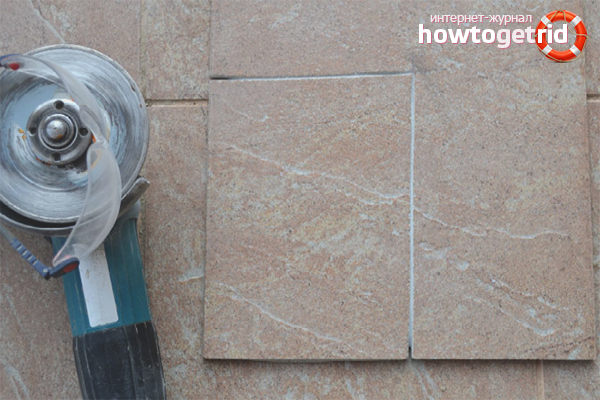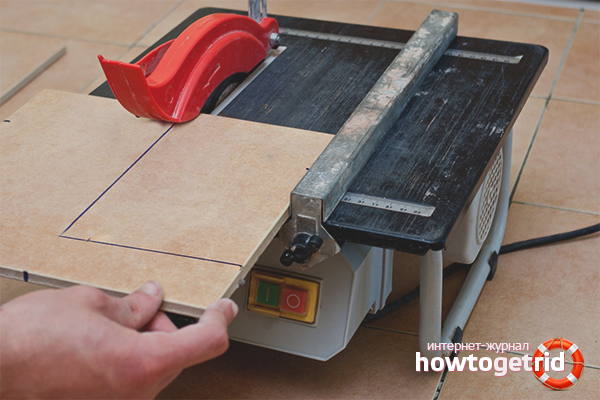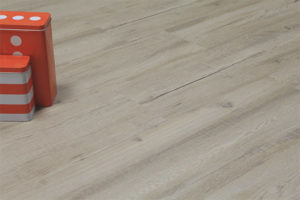The content of the article
Porcelain tile is a strong and at the same time fragile material. It is resistant to temperature changes and, unlike tiles, has high wear resistance. The material has refractory properties and low water absorption. Porcelain tile consists of compressed clay mixed with solid minerals, so it does not crumble and practically does not scratch. Cutting such a tile is harder than tile, but possible. The main thing is to choose the right way.
Classic method
Cladding material, the thickness of which does not exceed 8-10 mm, is divided into parts using a glass cutter. The tool with a diamond tip draw straight lines. Cut patterns or complex shapes will not work:
- Tiles are laid on the floor or table.
- Hold with your hands, you can step with your foot. The main thing is that the workpiece is securely fixed and does not move during operation.
- In addition to the glass cutter, you will need an iron ruler or a building level.
- A cut line is drawn with a pencil on the outside of the facing material. Apply a level to it.
- Spend on the granite surface with a diamond tip.
- The tool is pressed so that the blade penetrates into the inner layer of the tile.
- Strength is reduced when the glass cutter reaches the edge. If you put too much pressure on this section of the facing material, chips will appear.
If the incision is deep enough, the tile will split in two without serious damage. It is possible to separate the facing material with your hands, but this method is more dangerous. Small pieces of granite scatter in different directions, falling into the eyes. People who decide to break the facing material with their hands are advised to wear glasses and thick gloves.
The rough edges of the tiles are treated with a sanding mesh or a circle. Emery paper with large or medium abrasive particles is also suitable.
Beginners do not always succeed in breaking porcelain tiles into pieces without serious damage. If you decide to process the facing material with a glass cutter, you need to buy tiles with a margin and several tools. The diamond tip is quickly dull when it comes into contact with pressed clay.
Electrical devices
Porcelain tiles are cut with a grinder. A diamond-coated disc is put on an electric tool. The nozzle is one-piece, without teeth and holes, designed for dry cutting.
The tile is marked with a marker or chalk. Lines are drawn on the outside. Cladding material must be fixed on a table or other stable base. In order not to spoil the tile, 2-3 mm recede from the line. The grinder is turned on and carried out once on a granite surface. At the edges, the disk speed must be slowed down so that chips do not appear. You can’t repeat the tile again. If it was not possible to cut the workpiece the first time, it must be carefully broken with your hands or feet.
Grinder grind uneven edges. The dry cutting disc is replaced with a variety for stone. Turn on the electric tool at minimum speed and process the tile cut.
Glazed facing material is cut in another way. The grinder leaves too much chips and damage on the granite surface.After processing, the tiles have to be thrown away, because even grinding machines cannot eliminate defects.
A grinder is made not only straight, but also curved sections. Turn on the minimum speed and carefully draw along the previously outlined lines. Decorate a porcelain stoneware surface with patterns or complex patterns will not work. A grinder is able to cut a circle, triangle or other geometric shape with a minimum of detail. The disk is tilted at an angle of 45-60 degrees to the surface. After sawing, the edges of the granite are ground.
The method is quite dusty and noisy, therefore it is recommended to work with facing material on the street or in a ventilated room. Wear a gauze bandage or respirator, safety glasses and thick-soled boots. Hold the tool firmly during operation.
Tile decor
Complex patterns on a granite surface are cut with an electric jigsaw. The tool is equipped with a diamond wire, which is able to cut even such a durable cladding material.
First, patterns are drawn on the outside of the tile. Use a pencil or chalk, which is easily washed. The workpiece is fixed on the table. The surface is moistened with water, at least 8 mm back from the edge. The nozzle moves slowly and gradually. After each small curl, the instrument is turned off and the chips are brushed off the porcelain tile to see the pattern more clearly. Material is periodically sprayed with water from a spray bottle. Moisture will facilitate the sliding of the diamond wire and protect the tile from scratches and large chips.
Porcelain tiles can be decorated with complex patterns using a conventional drill. For thick workpieces, drills with a diameter of 8 and 12 mm are taken. Holes are made in a thin tile, the size of which does not exceed 4 and 6 mm, to prevent the occurrence of chips.
Pencils on the front surface draw conceived patterns. Carefully draw a contour and mark with points where the holes should be. It is recommended to observe a distance of 5 to 10 mm, you can slightly less. Be sure to deviate from the edges of at least 0.8 cm.
The first stage is drilling to an incomplete depth. The drill is equipped with a nozzle with a diameter of 8 or 4 mm, depending on the thickness of the material. Then apply a larger drill, which is inserted into the finished recesses. Slowly press on the drill, trying to get the tool into the tile to the very bottom.
Pieces of porcelain tile are separated from the tiles with dowels. Insert the nails into the drilled hole and lightly hit them with a hammer until a chipping appears on the surface to be treated. Sometimes the remains of pressed clay are removed with a chisel, and then the edges of the pattern are ground with coarse sandpaper.
Jigsaw and drill can handle a small amount of porcelain stoneware. Only specialists who have waterjet installations can cover with drawings of 100 or more tiles. The lining material is treated with a stream of water containing particles of sand or other solid material. It cuts through porcelain tiles, like an ordinary sheet of paper, without leaving chips or scratches. Edges of patterns after professional processing do not need to be ground. They are even and smooth.
Straight cut
A circular saw can divide a tile into 2–4 large pieces. Porcelain tiles are marked before work. The gear nozzle is replaced with a solid disk without holes, preferably with diamond spraying.
The tile is held with two hands and slowly moved to the included tool. The circular saw works slower than the grinder, but thanks to the adaptation, the slices are even and smooth, do not need to be ground.
Construction shops sell professional tile cutters. They are electrical and mechanical. The first type looks like a grinder. It has a round disk with diamond spraying, which easily cuts the tiles into pieces. It is sold complete with a bed to which porcelain tile is attached.Electric tile cutters are dry and wet. The second is equipped with a water tank, which moisturizes the instrument during operation. The liquid protects the equipment from overheating. An additional plus of a wet tool is the absence of dust.
A mechanical tile cutter is similar to a bed equipped with clamps and levers for fixing and bending porcelain stoneware. The tool has a cutter that will have to be changed periodically. Mechanical tile cutters are not designed to decorate tiles with patterns. They only make straight cuts. The advantage of this device is the absence of loud sounds and dust.
Tile cutters are bought by people who plan to continue repairing and laying ceramic granite tiles. They are quite expensive, so it's easier to use a grinder or a circular saw.
It is no more difficult to work with porcelain tiles than with tiles, if the right tools are at hand. A strong and brittle material can be cut by a circular saw and a grinder. Glass cutters will cope with thin tiles. And for ornate patterns there is a drill and a jigsaw with a wire nozzle.
Video: how to cut porcelain tile












Submit